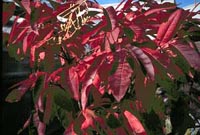Resource Library
Plant of the Week: Sourwood
The University of Arkansas System Division of Agriculture does not promote, support or recommend plants featured in "Plant of the Week." Please consult your local Extension office for plants suitable for your region.
Plant of the Week
Sourwood
Latin: Oxydendrum arboreum

Larry McMurtry, best selling author of Lonesome Dove and a score of other books, analogizes the nation’s interstate highway system to rivers. From either a flatboat on the Missouri or a car window on "the 40," you are a spectator to the activities of mankind and the nature which surrounds us, not a participant.
From a biologist’s perspective, the change of vegetation along a river is slow, only altering as the grip of winter forces more hardy species to establish themselves along its banks. But our interstates bisect the landscape and changes come more rapidly. Thus, it is only a short trip along I-40 east of Memphis when we first encounter sourwood, Oxydendrum arboreum, in its native range.
Sourwood, the largest tree in azalea family in North America, ranges from the southern tip of Illinois to the gulf coast in Louisiana to Florida. It does not occur wild in Arkansas, but it will grow here. Trees have a pyramidal profile when grown in the open and reach 30 feet tall in landscapes. They can reach twice that height in the wild. It occurs in the forest as an occasional tree, not as dense stands.
The tree has leaves identical to the shape of azalea leaves, but they may be 6 inches long. The leaves are a rich glossy green in the summer with mature trees displaying the most beautiful fall color in our southern landscape. If sourwoods were as numerous in our forests as are maples in the New England landscape, travelers would visit us in the fall instead of trekking north.
Flowers are another significant attribute of this beautiful tree. In mid-spring after the leaves have appeared, pendant panicles of small urn shaped white flowers are produced at the ends of branches. The flowers give rise to one of the plant’s common names - "Lily of the Valley Tree." In areas where the trees grow wild, they are a favorite bee tree for those tending the hive.
Donald Peattie is one of the most lyrical writers I know of when it comes to describing trees. In his 1966 reissue of A Natural History of Trees, he states:"One buys sourwood honey as one buys any such rare product from its producers - not in a commercial spirit, paying for it and carrying away the wares - but with all the due ceremony observed between a collector and a creative artist." His description of the dance that occurs between the farmer’s wife and the prospective buyer is a poetic rendition of mid-century American life which we will never see again.
Sourwood gets its name from the sour taste of the leaves and branches of the tree. They have a taste similar to that of oxalis leaves with the distinctive sharpness of oxalic acid. In past times, the leaves were brewed for herbal cures of various internal ailments.
As a member of the azalea family, sourwood grows best in acidic, well drained sites. In its native range, it’s often found on sandy, acidic sites. It’s not well suited for heavy clay soils. As a young tree, it grows irregularly and often fails to have a typical upright habit until well established.
Like all members of the azalea family it has fine, shallow roots and is sensitive to too much or too little water.
By: Gerald Klingaman, retired
Extension Horticulturist - Ornamentals
Extension News - September 7, 2001
The University of Arkansas System Division of Agriculture does not maintain lists of retail outlets where these plants can be purchased. Please check your local nursery or other retail outlets to ask about the availability of these plants for your growing area.